The OSFI's Intelligence-Led Cyber Resilience Testing (I-CRT) Framework - What You Need to Know
In April 2023, the Office of the Superintendent of Financial Institutions (OSFI), Canada’s agency responsible for regulating financial institutions, released their Intelligence-led Cyber Resilience Testing Framework (I-CRT)1. Canada’s I-CRT framework is based on similar intelligence-led frameworks which have been used in other countries, such as the Bank of England’s CBEST framework2 and the European Union’s TIBER-EU3.






